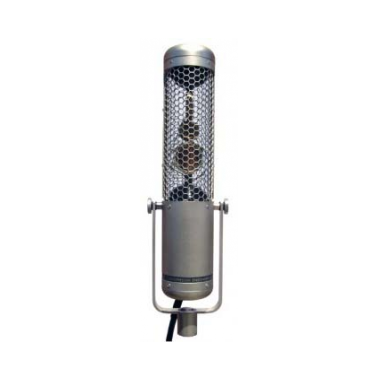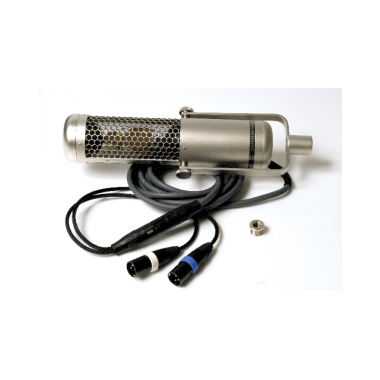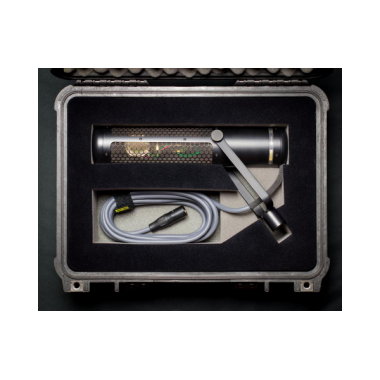- Flyline Music AG
Hauptmenü:
×
- index
-
Produkte
-
Mikrofone
-
3DIO
- Microphones
- Pro Microphones
- Accessoires
- AEA
- Antelope Audio
- Avantone Pro
- Bock Audio Design
-
Cascade Microphones
- Short Ribbons
- Long Ribbons
- Specialty Ribbons
- Accessoires
- Cloud Microphones
- Chandler Limited
- Coles Electroacoustics
- Dizengoff Audio
-
Earthworks
- Vocal Series
- PianoMic Series
- Drum Series
- SR Series
- TC Series
- QTC Series
- Periscope Series
- Measurement Series
- Accessoires
- Ear Trumpet Labs
- Granelli Audio Labs
- Josephson
- Kahayan Pro Audio
- Luke Audio
- Manley Labs
- Mojave Audio
- Placid Audio
- Roswell Pro Audio
- Royer Labs
- Sontronics
- Stager Microphones
- Townsend Labs
- Vanguard Audio Labs
- Warm Audio
-
3DIO
-
Studio Equipment
- A Designs Audio
- ACME Audio
- AEA
- AMS Neve
- Analoguetube
-
Antelope Audio
- Discrete Synergy Core Interfaces
- Discrete Interfaces
- HDX & USB Interfaces
- Thunderbolt & USB Interfaces
- Stereo Converters
- Master Clocks
- Mic Preamps
- Monitor Controller
- API
- Asparion
- Audified
- Avalon Designs
-
BAE
- Guitar Tools
- 500 Series
- Deskop Mic Preamps
- Modules & 19"
- Bettermaker
- Big Bear Audio
- Black Box
-
Black Lion Audio
-
500 Series
- Modules
- Rack
-
Outboard
- Mic Preamps
- Compressors
- Studio Clocks
-
500 Series
-
BURL Audio
- B1 500 Series Modules
- B2 Bombers
- B26 Orca
- B32 Vancouver
- B16 Mothership
- B80 Mothership
-
Chandler Limited
- Abbey Road Series
- 500 Series
- Germanium Series
- Rack Mixer
- Guitar Pedals
-
Cranborne Audio
- Outboard
- Desktop
-
500 Series
- Modules
- Racks
- Crane Song
-
Daking
- Preamplifiers
- Compressors
-
Dangerous Music
- Converters
- Controller
- Router
- Summierer
- Outboard
- Dave Hill Designs
- Dizengoff Audio
-
Drawmer
- Monitor Controller
- Sound Protection
- 60ies / 70ies Series
- MXPro Series
- Gates & Compressors
- Digital Management
- Signal Splitters
- Signal Distribution
- Power Amplifier
- Earthworks
-
Elysia
- 500 Series Modules
- 19" Outboard
-
Empirical Labs
- 500 Series
- 19" Outboard
- Plug-In
- Flock Audio
-
Fredenstein
- MixCube
- HD Reference Preamps
-
500 Series
- Artistic Modules
- F600 Modules
- Racks
- Vintage Analog Series
- Outboard Equipment
- Metering
- Grace Design
- Great River Electronics
-
Heritage Audio
- RAM Series
- Elite Series
- 500 Series
- Table Top Series
- 19" Outboard
- Classic Series
- Highland Dynamics
-
IGS Audio
- 500 Series
-
19" Outboard
- Spring Reverb
- Compressors
- Equalizers
- Preamplifier
- Interphase Audio
-
Inward Connections
- 500 Series Modules
- 19" Outboard
- JDK Audio
-
Kahayan Pro Audio
- Summing Mixers
- Amp/Speaker Selectors
- Preamplifier
-
Kush Audio
- 500 Series Modules
- 19" Outboard
-
La Chapell Audio
- 500 Series Modules
- 1/2 19" Outboard
- 19" Outboard
-
Lindell Audio
- 500 Series Modules
- 500 Series Racks
-
Lisson Grove
- 19" Outboard
- Little Labs
- Locomotive Audio
-
Looptrotter
- 500 Series Modules
- Outboard Equipment
- Modular Console
- Mäag Audio
-
Manley
- Mic Pres / Combos
- Equalizers
- Dynamics
- Maselec
-
Mercury Recording Equipment
-
500 Series
- Modules
- Racks
- Power Supplies
- Accessoires
- Vacuum Tube Outboard
- Solid State Outboard
- Custom Shop Outboard
-
500 Series
- Millennia
-
Mytek Digital
- Brooklyn Series
- Converters
- Private Q2
-
Overstayer
- 19" Outboard
- Pete's Place Audio
-
Phoenix Audio
- Desktop
- 500 Series
- 19" Outboard
- 1/2 19" Outboard
- Pultec
-
Purple Audio
- MFTwenty5 Rack Mixer
- 500 Series
- 19" Outboard
- Q2 Audio
-
Retro Instruments
- 500 Series Modules
- Portable Amplifier
- Outboard Equipment
-
Roger Schult
- 500 Series Modules
- 19" Outboard
-
Power Supplies
- Roll Music Systems
- Rupert Neve Designs
-
Serpent Audio
- 500 Series Modules
- 19" Outboard
-
Shadow Hills Industries
- 500 Series
- 19" Outbaord
-
Solid State Logic
- Audio Interfaces
- Small Format Consoles
- 500 Series
- Analogue Processors
- X-Rack System
- Digital Equipment
- Speck Electronics
-
Spectra 1964
- 19" Outboard
- Desktop
- 500 Series
- Standard Audio
-
Teegarden Audio
- DI Boxes
- Mic Preamps
-
Teknosign
- Box Line
- Preamplifier
- Summing Mixers
- Power Conditioner
- Patchbays/Adapters
- Thermionic Culture
-
TK Audio
- 500 Series Modules
- 19" Outboard
- Tonelux
- Tube Tech
- UK Sound by BAE
-
Universal Audio
- UAD-2 Live Rack
- OX The Amp Top Box
- Audio Interfaces
- UAD-2 Accelerators
- Analog Hardware
- Useful Arts Audio
- Vertigo Sound
- Warm Audio
- Wave Distro
- Weight Tank
- WesAudio
- Whitestone Audio
-
Monitoring
- Auratone
- Avantone Pro
-
Aviom
- FUGU Speakers
- Livemix
- Unity Audio
-
Electronic Sound
-
Mode Machines
- 19" Equipment
- Desktop
- MIDI Tools
- Pedals
- Sequential
-
Studio Electronics
- Boomstar Modular Synthesizers
- Boomstar Modular Eurorack
- Boomstar Desktop Synthesizers
- 19" Analog Synthesizers
-
Vermona
- Modular Module
- Synthesizer
- Drums & Percussion
- Effektgeräte
-
WMD
- Effect Pedals
-
Eurorack Modules
- Aperture
- Arpitecht
- Arpitecht Triad
- Buffered Multiple
- Chimera
- Compressor
- DVCA
- Fracture
- Geiger Counter
- Invert Offset
- Metron
- Micro Hadron Collider
- MSCL
- MM Envelope
- MM Extension
- MM VCA
- Overseer
- Performance Mixer
- PM Mutes Expander
- PM Channels
- PDO MKII
- PDO Triple Bipolar VCA
- Pro Output
- QAAF
- SSM
- SSM Expand
- Synchrodyne
- Synchrodyne Expand
- TRSHMSTR
-
WMD / SSF Collaboration
- Monolith Synthesizer
- Eurorack Modules
-
Mode Machines
-
Accessoires
-
ATR
- MDS-36 Tapes
- Precision Analog Master Tapes
-
Bittree
- Dante Patchbays
- TT Patchbays
- XLR / Jack Patchbays
- TT Patch Cables
- Accessoires
- Cloud Microphones
-
Latch Lake
- micKing®
- Xtra Booms
- iOxbooms
- Parts
-
Pete's Place Audio
- Pan 60
- Recording The Masters
- Scott Liebers
-
Sterling Modular
-
Multistation
-
Plan Consoles
- Racking Systems
-
Multistation
-
Teknosign
- Power Conditioner
- Patchbays/Adapters
-
Vovox
- sonorus
- link
- initio / textura
- sonorus XL
-
Zaor Studio Furniture
-
ATR
-
Mikrofone
- News
- Preislisten
- Links
- Kontakt
Produkte > Mikrofone > Josephson > Series Seven
Features
Technische Daten
Modelle / Preise
Zubehör
Hersteller
C700A / C700S
Grossmembran Kondensator Mikrofon
mit 2 oder 3 Kapseln
- Stereo- und/oder Surroundmikrofon
- C700A mit zwei Kapseln: Kugel und 8er
- C700S mit drei Kapsenl: Kugel und 2x 8er
- Richtcharakteristik im Mixdown bestimmbar
- Stereobreite im Mixdown regelbar
- Alle Kapseln mit internen Shockmounts
Series Seven microphones provide unprecedented flexibility, as the directional pattern of the mic can be adjusted in use, during or after recording. C700 microphones include omni/pressure and figure-8/gradient capsules, each with a discrete output. The signals can be recorded on separate tracks, so the pattern can be selected in mixdown. Pattern control is only one advantage of this technique. Applying different equalization or dynamic control to the capsule signals makes entirely different mic characteristics – for instance the warmth of a gradient mic used close up for vocals might be combined with the transparency of a pressure mic in the highs, by rolling off the high frequencies in the gradient signal and the lows in the pressure signal before they are combined.
The C700A includes two capsules in one housing, a 16mm omni element similar to the KA11 capsule in the Series Six, and a 26mm figure-8 capsule. Completely neutral electronics, using the same cascode FET input, class-A active balanced output circuit found in the Serie s Six, are provided for each signal. Any directional pattern from omni to figure-8 may be selected by controlling the ratio of pressure to gradient signals.
The C700S microphone has three capsules; an additional side-facing figure-8 capsule is added to the two in the C700A. Any coincident stereo pickup can be derived from mixing these three signals together, and like the C700A, the signals can be recorded individually and all aspects of image width and pattern control may be adjusted in the mixdown. With the three capsule signals, any number of microphone outputs may be created, each one pointed anywhere in the plane around the microphone.
The capsule assembly in the Series Seven is internally shock mounted, so that the mic may be attached directly to a stand through its yoke mount without any external accessories.
Using the C700A and C700S
The outputs of the C700A microphone are designated W for omni/pressure, X for front-facing figure-8/gradient; the C700S also has a Y output for side-facing figure-8/gradient. These native output signals from the microphone are equivalent to Soundfield “B-format” except that the height or “Z” channel is absent. Any desired pattern can be obtained by mixing these signals, and with the C700S the resultant output may be pointed in any direction. Any number of output channels may be derived by mixing additional copies of W, X and Y in different ratios.
Pattern selection (C700A and S)
Omni: all W
Subcardioid/hypocardioid: W with X mixed in about –6 dB
Cardioid: equal amounts of W and X
Supercardioid/hypercardioid: X with W mixed in about –6 dB
Figure 8: all X
To reverse direction (unidirectional patterns favoring the rear of the mic) invert phase of the X signal
MS Stereo (C700S)
The M or mid signal is formed by mixing W and X. If the signals are at the same level, a cardioid pattern will result.
The Y signal is equivalent to the S or side signal in MS Stereo.
XY Stereo (C700S)
MS can be converted to left/right using the usual matrix, M+S=left, M-S=right. On a mixer, this is accomplished by connecting the W and X signals to mixer inputs panned center. A Y-cord is needed to split the output of the Y channel into two more mixer inputs. The first of these is panned left, the second is phase inverted and panned right. Pattern is adjusted by controlling the ratio of W and X; raising the level of the Y and inverted-Y signals panned left and right controls the width.
Surround formats (C700S)
The five primary surround channels can be derived using the XY stereo recipe above for the front, and making a duplicate set (with the X signal inverted) for the rear.
Left front: W+X+Y
Center front: W+X
Right front: W+X-Y
Left rear: W-X+Y
Right rear: W-X-Y
The W signal has flat response to below 20 Hz and can be used alone, with suitable lowpass filtering, as the 0.1 or LFE channel. Side-facing channels may be derived using the W and Y signals just as forward-facing channels are made with W
and X.
C700A / C700S
Grossmembran Kondensator Mikrofon
mit 2 oder 3 Kapseln
Type: Pressure and pressure gradient condenser mics
Pattern: Variable directional pattern
Frequency range: 20-20,000 Hz ±2 dB
Sensitivity: –41 dB ref 1 V/Pa (9 mV/Pa) for each signal
Overload sound pressure: 135 dB SPL at 1kΩ load
Equivalent noise level: 15 dB SPL, A-weighted
Power supply: P48 phantom, 4 mA per output
Dimensions:
Diameter: 63mm (100 mm wide at yoke)
Length: 328 mm (C700A), 365 mm (C700S)
Output connector: 5-pin XLR type (C700A)
7-pin XLR type (C700S)
C700A / C700S
Grossmembran Kondensator Mikrofon
mit 2 oder 3 Kapseln
Latch Lake micKing 1100: Mikrofonständer
Latch Lake micKing 3300: Heavy-Duty Mikrofonständer
Josephson Engineering
Santa Cruz CA, USA
Josephson Engineering makes a wide range of fine condenser microphones for studio, stage and field sound pickup, and audio instrumentation. The company began in San Jose, California in 1988 and moved to Santa Cruz in 2000... more than 25 years of making microphones. All of our products are designed and manufactured in our facility in Santa Cruz.
In the process of developing our own mics, we've come up with special technologies that let us realize designs that weren't possible in classics of years past. This means that the expert user has a wider range of sound choices, without many of the compromises of older designs. Besides our own production, we also supply microphone capsules to several other mic manufacturers that become the mics for their most demanding customers. All of our business is individual -- we use select local dealers who bring our product directly to critical users around the world.
We have a standard product line that covers many applications, but if there's a microphone you need that we don't make, we'll either tell you about the best one we know of for that job, or make it for you ourselves. We won't tell you that one of our mics is good for everything -- there's no such thing.
Josephson also provides electro-acoustical engineering, design and manufacturing services for challenging requirements in many industries, specializing in microphone transducers and supporting systems. Our OEM capabilities have allowed several companies to excel in their own markets, using capsules made by Josephson.
Copyright 2017. All rights reserved.










